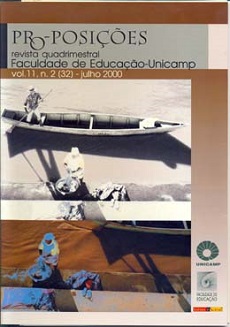Abstract
O ensaio trata dos desafios impostos à historiografia pelo evento de Auschwitz. Por um lado a relação entre historiografia e memória é reelaborada e discutida mais a fundo - superando-se a divisão rígida entre ambas modalidades de relacionamento com o passado - por outro lado, diante do negacionismo e das tentativas de normalização do passado impõe-se a necessidade de se pensar uma nova éticada representação.Nesse contexto o testemunhoocupa um local privilegiado, na medida em que - na qualidade de um traçodo ocorrido - auxilia na construção de uma imagem do passado para além tanto do positivismo, como também do relativismo pós-moderno. Autores centrais na construção dessa nova ética da história e da memória: S.Freud,W. Benjamin,M. Halbwachs,J. Derrida e S.Friedlander.
Abstract:
The issue of the present essay isthe challenge imposed to historiography by the event of Auschwitz. Ifit istrue that merelationship between historiography and memory is being revised and discussed in depth - abolishing the rigid division between both modalities of relation with the past (historiographyandmemory)- it is also true that it becomes urgent to think a new ethicsofrepresentation, do to the negationisms and the tentatives of normalization of the pastoIn our concern, testimony occupies a central place, since it helps - in the quality of a trace of the occurrence - the construction of one image of the past, which suppresses both, positivism and me post-modern relativism. Some of me authors who are central to me discussion of this new ethics ofhistory and memory are: S. Freud, W. Benjamin, M. Halbwachs, J.Derrida and S. Friedlander. Descriptors: testimony, holocaust, history of everyday life, memory, trauma.
References
Benjamin, W. (1982). GesammelteSchrifien,vol. V: DasPassagen-Werk,org. por R.1iedemann e H.
Schweppenhauser, Frankfurt: Suhrkamp.
Boyarin, J. e Kugelmas, J. (1983). From a ruined garden. The memorial booksof polishjewry, Nova York:Schocken Books.
Derrida, J. (1998). Demeure.Maurice Blanchot. Paris: Galilée.
Friedlander, S. (org.) (1992). Probing the limits ofrepresentation.Nazism and thefinal solution,Cambridge, Massachuserrs/London, England: Harvard UP.
_, e Broszat, M. (1990). A controversy about the historicization of national socialism, Peter Baldwin (ed.), Reworking the pastoHitler, the holocaustand the historians, Boston: Beacon Press, pp.102-134.
Goldhagen, D. (1996). Hitlers willing executioners:ordinarygermans and the holocaust,Nova Iorque: Knopf. (OsexecutoresvoluntdriosdeHitler:alemãescomunse oholocausto,São Paulo:Companhia das Letras, 1997).
Habermas,J. (I 998). DiepostnationaleKonstellation.Politischeessays,Frankfurt: Suhrkamp (A constelação pós-nacional.Ensaiospollticos, trad. M. Seligmann-Silva, São Paulo: Lirrera Mundi, no prelo).
Halbwachs, M. (1950). Ia mémoire collective,Paris: PressesUniversitaires de France.
_ (1990). A memória coletiva,São Paulo: Vértice.
Jay,M. (I998). Songs of experience: reflections on the debate overAlltagsgeschichte,Cultural Semantics:keywordsofour time, Arnherst: U. ofMassachuserrs Press, pp. 37-46.
LaCapra, D. (1998). History and memory afierAuschwitz, Ithaca e Londres: Comell U. Press.
Nora, P.(1984). Entre mémoire et histoire. La problématique des lieux, Leslieux de Iamémoire,Paris: Gallimard, vol I, pp. XV-XLII.
Pollak, M. (1989). Memória, esquecimento, silêncio, Estudoshistóricos,Rio de Janeiro: vol. 2, n" 3, pp.3-15.
_ (1990). L'expérienceconcentrationnaire.Essaisurle maintien de l'identité sociale,Paris: Éditions Métailié.
Seligmann-Silva, M. (1997). 'Ein Vólk von Mordem': Tese sobre anti-semitismo eliminatório alemão gera polêmica na Alemanha", Projekt, n" 27/28, (dezembro), pp. 35-40.
_ (1998). Literatura de testemunho: oslimites entre a construção e a ficção, in: RevistaLetras,n" 16,janeiro/junho (UFSM - Centro de Artes e Letras - Mestrado em Letras, dossiê: literatura, violência e direitos humanos), pp. 9-37.
(1998/1999). História como Trauma, Pulsional. Revisra de Psicanálise, Ed. Escuta, n" 116/ 117, (dezembro/janeiro), pp. 108-127. (in: Márcio Seligmann-Silva e A. Nestrovski (org.) Catdstroft~"pr~sentllfão, São Paulo: Escuta, no prelo).
_ (1999). A literatura do trauma, Cult, ng23, junho 1999 (Dossiê: Literatura de testemunho, org. por M. Seligmann-Silva., pp. 39-63), pp. 40-47.
Semprún, J.(1990). Mal ~tmodernité, Paris: Éditions Climats.
Vidal-Naquet, P. (1987). ús assassinsde Ia mémoir~. "Un Eichmann depapi" "~t autr~sessaissur k révisionism~,Paris: La Découvene.
- (1996). Losjudios, Ia m~oria y ~lpr~smt~, Buenos Aires: Fondo de CultUra Económica de Argentina.
Wieviorka, A. (1998). L'éredu témoin, Paris: Plon.
_ e Niborski, I. (1983). ÚS livresdu souvenir,mémoriauxjuifi de Pologn~,Archives-Gallimard.
Yerushalmi, Y. H. (1988). Réflexions sur l'oubli, Usag~sde l'oubli (diversos autores), Paris: Éditions du Seuil, pp. 7-21.
A Proposições utiliza a licença do Creative Commons (CC), preservando assim, a integridade dos artigos em ambiente de acesso aberto.

